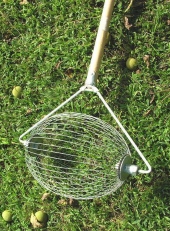I'm looking to install a RMH in my "office", which would be about 300 square feet, and attached via a pair of doors to a non-insulated 600 square foot "party room" in one of our sheds. So I bought
Ernie and Erica's 6" system plans and the
Rocket Mass Heater book by Ianto Evans and Leslie Jackson.
Before I build that, or even start collecting materials, I wanted to have a better understanding of what makes RMHs work (and not work). I took a quick look at the diagram of the core in Ianto's book, and then a friend and I spent ten minutes chipping cement off some old bricks, and another 10 minutes stacking them up, giving me this:
We fired it up, and it sucked (no, not the good rockety way). Basically we lit a fire in the chimney to get some draft happening, and also lit the fire in the bottom of the feed chute. We did get a horizontal burn when the fire was right at the bottom, however as soon as it started to burn up into the fuel there wasn't enough draft to pull it back down. We tried removing a course of bricks from the feed and adding it to the chimney, and that helped some. We noticed that when the fuel was pushed into the burn tunnel, it drew better. So we took the feed chamber down entirely, and watched that for a while
(here's my friend watching - he works at power stations. I think he's marvelling at the fact that fires can consume less than 2600 tonnes of coal per hour)
At this point, I remembered that the diagram had shown the burn tunnel being taller. Not wanting to start over, we pushed the coals into the chimney, and then dug down in between the walls using a mattock
(I'm posting this picture because the short side was what we used to remove the cement from the bricks - a single tap would take it off!)
We resurrected the feed chamber, and it was a little better. Then I scooped up the ash and dirt we'd dug out and covered the worst of the gaps in the burn tunnel. This had an immediate and dramatic improvement. We then added another three courses of bricks (they had holes in, so we had to lay them the other way) and that made further improvement. Anyway, this was the finished product.
We discovered that if you dropped a long strip of eucalyptus bark in the chimney, it would burst into flames and cause some serious rocketyness. We also discovered that if you threw a half dozen brown coal briquettes (calm down!) into the feed chamber, it created so much heat you could no longer look down the chimney. My friend commented something along the lines of "Yeah, there's a reason fossil fuels kick ass".
My plan next weekend is to make up some cob (never done that before) and try and cover up all the gaps in the lower part of the structure.
One question that springs to mind is would a diagonal burn tunnel (maybe rising one brick width over its length) help reduce the risk of smoke back? Seems like it would make it easier to light and easier to clean too.









